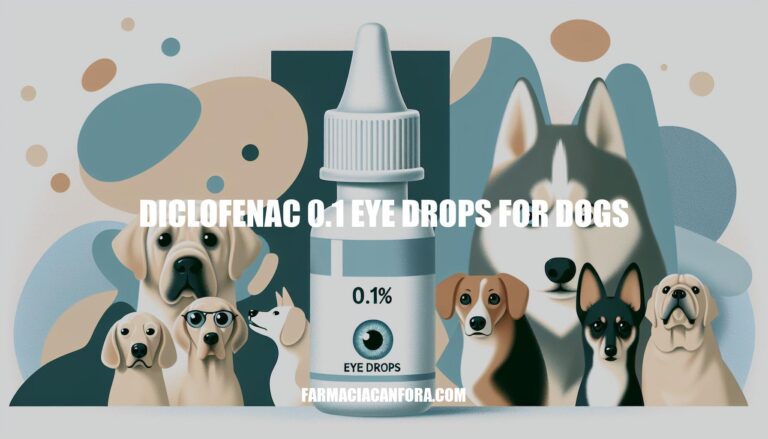Diclofenac 0.1% eye drops are a nonsteroidal anti-inflammatory drug (NSAID) used in veterinary medicine to treat inflammation in dogs’ eyes. They are commonly prescribed to manage conditions like uveitis and to reduce pain and swelling after eye surgeries.
Mechanism of Action
Diclofenac 0.1% eye drops for dogs are nonsteroidal anti-inflammatory drugs (NSAIDs). They work by inhibiting the production of prostaglandins, which are compounds that trigger inflammation. By reducing prostaglandin levels, diclofenac decreases inflammation, swelling, and pain in the eyes, making it particularly useful after eye surgeries like cataract removal.
Indications
Here are the specific conditions and situations where diclofenac 0.1% eye drops are prescribed for dogs:
- Post-surgery inflammation (e.g., after cataract surgery)
- Chronic uveitis
- Anterior uveitis
- Iritis (inflammation of the iris)
- Lens-induced uveitis
- Preoperative and postoperative anti-inflammatory agent
Administration and Dosage
Sure, here are the detailed instructions for administering diclofenac 0.1% eye drops to dogs:
-
Preparation:
- Wash your hands thoroughly before handling the eye drops.
- Shake the bottle gently if instructed by your veterinarian.
-
Dosage:
- The typical dosage is one drop in the affected eye(s).
-
Frequency:
- For active uveitis: Administer 2 to 3 times daily.
- For chronic uveitis: Administer 1 to 2 times daily.
-
Application:
- Hold your dog securely. You may need assistance to keep your dog still.
- Tilt your dog’s head back slightly.
- Gently pull down the lower eyelid to create a small pocket.
- Hold the dropper close to the eye without touching it.
- Squeeze one drop into the pocket of the lower eyelid.
- Release the eyelid and allow your dog to blink to spread the medication.
-
Post-Application:
- Wipe away any excess medication with a clean tissue.
- Wash your hands again after administering the drops.
-
Precautions:
- Avoid using the drops if your dog has a known allergy to diclofenac or other NSAIDs.
- Do not use if there is an eye hemorrhage or corneal ulceration.
- Monitor for any signs of adverse reactions, such as increased redness, swelling, or discharge, and contact your veterinarian if these occur.
Always follow your veterinarian’s specific instructions and consult them if you have any concerns or questions about the treatment.
Precautions and Side Effects
When using diclofenac 0.1% eye drops for dogs, it’s important to be aware of potential side effects and necessary precautions:
Side Effects
- Burning or Stinging: Dogs may experience a burning or stinging sensation upon application.
- Increased Bleeding: Diclofenac can increase the risk of bleeding, especially if there are pre-existing eye hemorrhages or systemic clotting abnormalities.
- Delayed Wound Healing: This medication can delay wound healing, so it should be avoided if there is corneal ulceration.
- Sensitivity to Light: Dogs may become more sensitive to bright light.
Precautions
- Hypersensitivity: Do not use if the dog has a known hypersensitivity or allergy to diclofenac or other NSAIDs.
- Eye Pressure Monitoring: Careful monitoring of intraocular pressure is necessary, especially in cases of glaucoma.
- Post-Surgery Use: Use cautiously during the active wound-healing phase following eye surgery.
Interactions with Other Medications
- Corticosteroids: Diclofenac may interact with corticosteroids, so consult your veterinarian if your dog is on these medications.
- Other NSAIDs: Avoid using other NSAIDs concurrently to prevent increased risk of side effects.
Always consult your veterinarian before starting or combining medications to ensure the safety and well-being of your pet.
Diclofenac 0.1% Eye Drops: A Nonsteroidal Anti-Inflammatory Drug for Dogs
Diclofenac 0.1% eye drops are a nonsteroidal anti-inflammatory drug (NSAID) used to treat inflammation in dogs’ eyes, particularly after eye surgeries like cataract removal.
They work by reducing prostaglandin levels, decreasing inflammation, swelling, and pain. Diclofenac is prescribed for conditions such as:
- Uveitis
- Iritis
- Lens-induced uveitis
- Post-surgery inflammation
Administration Instructions
To administer the drops, follow these steps:
- Wash hands thoroughly.
- Shake the bottle if instructed to do so.
- Put one drop in the affected eye(s).
- Apply 2-3 times daily for active uveitis or 1-2 times daily for chronic uveitis.
Precautions
Avoid using diclofenac eye drops if your dog has:
- A known allergy to diclofenac or other NSAIDs.
- An eye hemorrhage.
- A corneal ulceration.
Monitoring for Side Effects
Watch for side effects such as:
- Burning or stinging sensations in the eyes.
- Increased bleeding.
- Sensitivity to light.
Consult a Veterinarian
Consult with your veterinarian before starting treatment and for any concerns or questions you may have.


